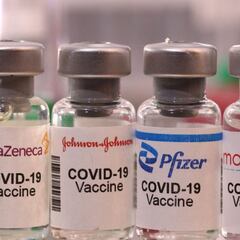Calculating the risk of reinfection from Omicron
A study conducted by the Italian Health Institute has revealed that reinfections have increased considerably with the new variant. What else can we learn?

Since its appearance at the end of last year, Omicron has become a challenge for virologists around the world due to its high transmission rate, one that led to a new wave of infections in many countries. In addition, its arrival is normalising something that until now was uncommon, the instances of reinfections.
How common are Omicron reinfections?
There have been an increasing amount of cases of people who have been infected more than once with covid, which has been a cause for concern. According to the Italian daily Corriere della Sera, a study by Italy's Higher Institute of Health (ISS) revealed that between 24 August 2021 and 9 January 2022, 2.7% of infections (more than 108,000) were reinfections, but in the last week this percentage has risen to 3.2%. The period between October and December showed reinfections accounting for around 1% of cases, as Omicron was starting to take over.
In related news:
- Omicron variant: latest news
- Will everyone need a fourth covid-19 vaccine dose?
- Clinical trials for Omicron-specific vaccine underway
Imperial College London has also been investigating these infections and has found that Omicron reinfection is more than five times greater than with the Delta variant. What this clearly means is that having been previously infected is no longer as protective against reinfection (it could be as low as 19%) unlike with previous variants, when it was estimated at 85%.
More reinfections, less severity
This information clearly has a greater impact on certain cases. In particular, the unvaccinated and healthcare workers are the most likely to be reinfected. Data collected by the Italian ISS between mid-December and mid-January shows that 21,000 reinfections were in unvaccinated people, 2,800 were in people who had at least one dose at the time of first diagnosis and 65,000 had been inoculated for the first time after the first infection.
Until we have more time we will not have more data-in the meantime the short term data does not look good for prior infection #immunity from #omicrom be cautious protect yourself and OTHERS who may not be as "lucky" #COVID19 https://t.co/gue0AGiMfi
— Marjorie Decker (@MarjorieDecker) January 30, 2022
Among health workers, in that single month there had been more than 4,000 reinfections compared to 37,000 cases of first infections, while in the rest of the population the difference was 72,000 reinfections compared to two million first infections. By age group, it is shown to have been more common in young people, with those aged 20-39 years accounting for 39% of all reinfections, while those aged 40-59 years account for 34%.
Related stories
That all said, Mario Clerici, professor at the University of Milan, has reassured people about the seriousness of these Omicron cases.
"We have very solid data showing how T-cells, the immune memory cells, remain active even in the face of the new variant, preventing severe forms of disease," he said.

